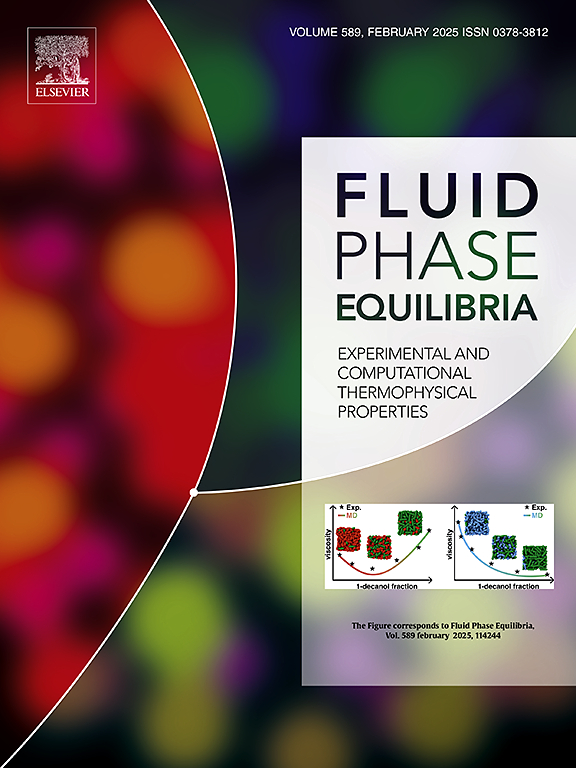CO2在1-甲基哌嗪水溶液中的溶解度及其与2-氨基-2-甲基-1-丙醇的混合物:新的实验数据和利用随机森林模型进行准确预测
IF 2.7
3区 工程技术
Q3 CHEMISTRY, PHYSICAL
引用次数: 0
摘要
一项具有增强性质的胺的新研究对于其作为CO2吸收过程的适当溶剂至关重要。这对于克服目前实施大规模二氧化碳捕集的财政和环境障碍至关重要。在本工作中,确定了1-甲基哌嗪(1-MPZ)和2-氨基-2-甲基-1-丙醇(AMP)为良好的水溶液混合物。1-MPZ具有较高的热阻和较低的CO2再生成本,使其成为该工艺的潜在候选材料。本文介绍了CO2在1-MPZ水溶液及其与AMP共混物中的平衡溶解度实验结果,以及1-MPZ水溶液及其与AMP共混物的新蒸汽压数据。该研究检测了CO2在1-MPZ的0.10、0.20、0.30和0.40 wt分数(w)和303.15、313.15、323.15和393.15 K温度下的溶解度。本文还对新型AMP + 1-MPZ混合料进行了CO2溶解度实验。通过改变1-MPZ和AMP的浓度,制备了四组不同的样品;在相同温度范围内保持总胺浓度0.40 w。实验结果表明,水溶液1-MPZ具有良好的CO2循环吸收能力,与AMP结合后,这种循环吸收能力进一步增强。结果表明,在正常吸收温度和组成条件下,水溶液1-MPZ具有较高的CO2溶解度,CO2溶解度为0.78 ~ 1.01 mol /mol胺。再一次,向AMP中加入1-MPZ增加了循环容量。混合胺(AMP+ 1-MPZ)的循环容量为118 g CO2/kg-溶液,而相同胺强度的1-MPZ的循环容量仅为81 g CO2/kg-溶液。因此,混合溶剂的循环容量增加了约45%。1-MPZ+AMP的组合允许在溶解度和再生效率方面提高性能。该研究还结合了随机森林(RF)机器学习模型,根据温度、浓度和二氧化碳分压等参数预测二氧化碳的溶解度。RF模型具有较好的预测精度,两种溶液的R2分别为0.98和0.99,1-MPZ和(1-MPZ +AMP)混合物的RMSE最小值分别为0.03和0.02。本文章由计算机程序翻译,如有差异,请以英文原文为准。
CO2 solubility in aqueous 1-methylpiperazine and its blend with 2-amino-2-methyl-1-propanol: New experimental data and leveraging Random Forest model for accurate prediction
A new study of amines with enhanced properties is crucial for its use as an appropriate solvent for CO2 absorption process. This is essential to overcome current financial and environmental obstacles to implementing large-scale CO2 capture. In this work, the identified amines to formulate a good aqueous solvent mix are 1-methylpiperazine (1-MPZ) and 2-amino-2-methyl-1-propanol (AMP). 1-MPZ has a higher thermal resistance and lower CO2 regeneration cost, which makes it a potential candidate for the process. This paper presents the results of experiments on the equilibrium solubility of CO2 in aqueous 1-MPZ solutions and its blends with AMP along with new vapor pressure data for aqueous 1-MPZ and its blend with AMP. The study examined CO2 solubility at 0.10, 0.20, 0.30, and 0.40 wt fraction (w) of 1-MPZ and temperatures of 303.15, 313.15, 323.15, and 393.15 K. The CO2 solubility experiments for the new blended mixture of AMP + 1-MPZ were also performed in this study. Four different sets were prepared by varying the individual concentrations of 1-MPZ and AMP; keeping the total amine concentration 0.40 w for the same temperature range. The experimental results indicate that aqueous 1-MPZ exhibits good cyclic capacity for CO2 intake which further enhances when combined with AMP. Results indicate that aqueous 1-MPZ exhibits high CO2 solubility of 0.78 to 1.01 moles of CO2/moles of amine at normal absorber conditions of temperature and composition. Again, the addition of 1-MPZ to AMP has increased the cyclic capacity. The blended aqueous amine (AMP+ 1-MPZ) shows a cyclic capacity of 118 g CO2/kg-solution whereas aqueous 1-MPZ of the same amine strength shows only 81 g CO2/kg-solution. Hence, an increase of about 45% cyclic capacity is achieved with the blended solvent. The combination of 1-MPZ+AMP allows for improved performance in terms of both solubility and regeneration efficiency. The study also incorporated Random Forest (RF) machine learning model to predict CO2 solubility based on parameters like temperature, concentration, and CO2 partial pressure. The RF model demonstrated excellent prediction accuracy with R2 values of 0.98 and 0.99 for both solutions and least RMSE values of 0.03 and 0.02 for 1-MPZ and (1-MPZ +AMP) blend respectively.
求助全文
通过发布文献求助,成功后即可免费获取论文全文。
去求助
来源期刊

Fluid Phase Equilibria
工程技术-工程:化工
CiteScore
5.30
自引率
15.40%
发文量
223
审稿时长
53 days
期刊介绍:
Fluid Phase Equilibria publishes high-quality papers dealing with experimental, theoretical, and applied research related to equilibrium and transport properties of fluids, solids, and interfaces. Subjects of interest include physical/phase and chemical equilibria; equilibrium and nonequilibrium thermophysical properties; fundamental thermodynamic relations; and stability. The systems central to the journal include pure substances and mixtures of organic and inorganic materials, including polymers, biochemicals, and surfactants with sufficient characterization of composition and purity for the results to be reproduced. Alloys are of interest only when thermodynamic studies are included, purely material studies will not be considered. In all cases, authors are expected to provide physical or chemical interpretations of the results.
Experimental research can include measurements under all conditions of temperature, pressure, and composition, including critical and supercritical. Measurements are to be associated with systems and conditions of fundamental or applied interest, and may not be only a collection of routine data, such as physical property or solubility measurements at limited pressures and temperatures close to ambient, or surfactant studies focussed strictly on micellisation or micelle structure. Papers reporting common data must be accompanied by new physical insights and/or contemporary or new theory or techniques.
 求助内容:
求助内容: 应助结果提醒方式:
应助结果提醒方式:


